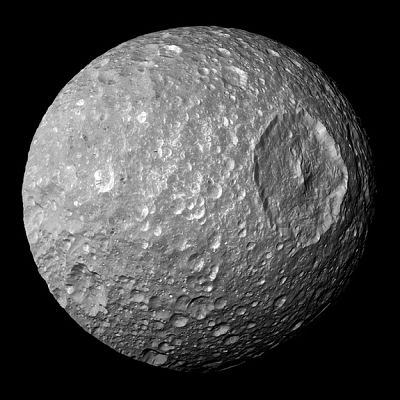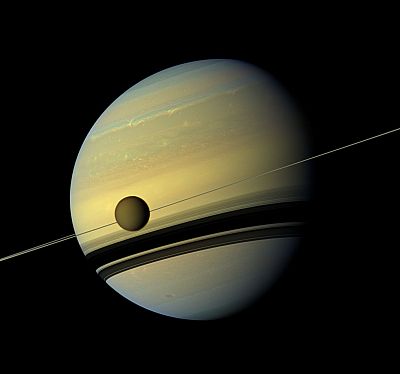The sixth planet from the sun has spectacular rings and dozens of moons, including one that scientists find especially intriguing.
What's your favorite planet? Many people pick Saturn, and no wonder. With its spectacular rings and a remarkable moon with its own atmosphere — the enigmatic Titan — Saturn is unique in our solar system.
No one can take credit for "discovering" Saturn. Like the other four planets visible to the naked eye (Mercury, Venus, Mars and Jupiter), Saturn has been known since antiquity. Its rings, however, weren't seen in detail until the middle of the 17th century, when Dutch astronomer Christiaan Huygens peered at the planet through a 50-power telescope.
Since then, we've learned a lot more about the sixth planet from the sun — especially in the last few decades, thanks to robotic spacecraft such as Pioneer 11, Voyagers 1 and 2 and, most recently, Cassini.
Short days and long years
With a diameter of about 72,000 miles, Saturn is nine times larger than Earth and bigger than all the other planets except Jupiter.
Like the other outer planets, Saturn is a gas giant. That means it's mostly hydrogen and helium. It probably lacks a solid surface, though its semisolid core, which contains metals such as iron and nickel, is much denser than the outer layers. On average, however, Saturn is less dense than water. If you had a big enough bathtub, it would float.
Saturn spins quickly. One "day" on the ringed planet lasts about 11 hours, as compared to 24 hours on Earth. Meanwhile, its "year" is much longer than a year on Earth; Saturn takes more than 29 years to complete one revolution around the sun.
And Saturn is far, far away: Its average distance from the sun is a bit less than 900 million miles (Earth is about 93 million miles from the sun). Its extreme distance from the sun makes Saturn a pretty chilly place: the average temperature is about minus 288 degrees Fahrenheit. Viewed from Saturn, the sun appears 100 times dimmer than it looks from Earth.
Spectacular ring system
Saturn's rings aren't solid but are made up of billions of chunks of rock and ice in orbit around Saturn. Where did all that stuff come from?
"The simplest way to get a lot of debris like that is through a collision or a series of collisions," likely between an asteroid or a comet and one of the planet's moons, says Elizabeth Turtle, a planetary scientist at the Johns Hopkins University's Applied Physics Laboratory in Laurel, Maryland.
Space
Though we speak informally of Saturn's "rings," astronomers describe it as a ring system, with gaps between the individual rings. (Astronomers identify each ring by a letter; the bright A, B and C rings are visible with a large backyard telescope; the D, E, F and G rings are much fainter.)
The chunks that make up the rings vary in size. Most are probably no bigger than dust grains, while the largest might be house-sized, with a few outliers as big as a mountain. Yet compared to the ring system's overall diameter of 175,000 miles, the rings are incredibly slim. If you could shrink the rings so that they spanned the distance from San Francisco to New York City, they'd be just five inches thick, on average.
Dozens of moons — some of them downright weird
Thanks to Cassini and the other robotic spacecraft that have visited Saturn, we know that the giant planet has at least 53 moons. Most are tiny, no more than a few miles wide, though 13 of them are more than 30 miles across.
Of these, the oddest may be Mimas, which features a vast crater roughly one-third the size of the moon itself. The crater gives Mimas more than a passing resemblance to the Death Star in the original "Star Wars" movie.
Also noteworthy is Enceladus, whose icy surface is believed to cover a liquid-water ocean. Some astronomers believe the ocean may contain the chemical ingredients required for life, such as molecular hydrogen and amino acids.
Titan, a world with air thicker than Earth's
As compelling as Mimas and Enceladus are, the Saturnian moon that excites scientists the most is Titan. With a diameter of 3,200 miles, Titan is the second-largest moon in the solar system (only Jupiter's moon Ganymede is bigger) and is even bigger than the planet Mercury. And Titan is the only moon known to have a substantial atmosphere.
Titan's air — a mixture of nitrogen and methane — is 50 percent thicker than Earth's. If you strapped on a pair of wings, you could probably soar through the air without too much difficulty, Turtle says. "People could fly if you put wings on them," she says. "But you'd need a warm sweater and you'd need some oxygen."
Though Titan's atmosphere would be toxic to us today, scientists believe it may closely mimic the atmosphere on Earth billions of years ago, when life first took hold.
We'll get a closer look at Titan in 2034, when NASA's recently approved Dragonfly mission reaches there (it's due for launch in 2026). When it reaches Titan, the Dragonfly spacecraft will deploy a 10-foot-long robotic drone equipped with propellers and skids. The drone will spend two and a half years exploring Titan and could give new insights into the chemical processes that paved the way for the formation of life on Earth.
Want more stories about space?
- Super-detailed black hole simulations solved a longstanding mystery
- Life on Mars? NASA's Curiosity rover detects 'unusually high' levels of methane
- Apollo moon rocks may unlock more secrets about our solar system
SIGN UP FOR THE MACH NEWSLETTER AND FOLLOW NBC NEWS MACH ON TWITTER, FACEBOOK, AND INSTAGRAM.













